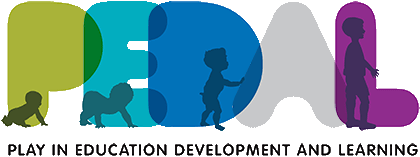As a Research Assistant in the PEDAL Centre, I am lucky to regularly visit classrooms and early years settings and think about why active, hands-on approaches to learning are beneficial for children. I often see that games allow children to be creative, practice complex cognitive skills, and provide rich learning experiences.
What exactly are games?
Broadly speaking, games can be characterised as activities requiring a set of rules and a reward that is gained through a team or an individual’s struggle for success.
In 1951, Historian Johan Huizinga defined a game as “a free activity standing quite consciously outside ‘ordinary’ life as being ‘not serious’, […] no benefit, and no profit can be gained by it”. This early definition suggested that a game is a game essentially because it is enjoyable.
In contrast, a recent wave of research has adopted the phrase, “serious games”. These can be described as “games that do not have entertainment, enjoyment or fun as their primary purpose”. This reflects growing acknowledgement that games can bring significant educational benefits, but places much less importance on enjoyment.
In contrast to both these views, many people would argue that enjoyment and education need not be mutually exclusive. Games can both capture a child’s imagination and interest and direct their attention towards a learning goal.
Games and creativity
Creativity is an essential skill for children, which enables them to think critically and solve new problems. Games offer opportunities for creative and more memorable learning experiences.
I recently saw a teacher embrace creativity during a game which aimed to teach the names of 3D shapes. In teams, children searched the classroom for examples of a particular 3D shape and filled the carpet with many, varied objects. They were excited to grasp new words for objects they were familiar with, and motivated to find as many examples as possible. When one team flew a large spaceship into the classroom, they decided they could only find out if it was a cube or a cuboid by measuring the sides with a meter stick. After all, they would only receive a point for the spaceship if they gave it the correct technical name.
The role of the teacher was essential to making sure this game was beneficial and enjoyable for the children. She stood back to monitor the children’s engagement and seized on moments of enthusiasm and imagination. By questioning children and encouraging them to reflect on their own thinking, the teacher developed a creative, playful lesson with a clear learning goal.
Games and cognition
Cognitive skills include the ability to learn, pay attention, remember and problem-solve. These skills enable children to ignore distractions, complete a multi-step task, or adjust their behaviour if something unexpected happens.
These skills can be developed through very simple games. I saw this through a game that involved a small group of children sat in a circle with the teacher. One child picked up a card from the middle, and the group guessed the number by taking turns to ask questions such as, “Is the number even?”, “Is the number bigger than ten?” etc. To reach the correct answer in this game, children had to remember the numerous questions and answers that came before them and inhibit their impulse to contribute before it was their turn.
The teacher facilitated children’s self-regulation by valuing the learning process just as much as the final answer. She introduced the game as an intriguing puzzle and encouraged children to be thoughtful about the questions and answers. When children were getting overly excited, she reminded them to pause and explained why taking turns would help them all to learn.
Games and the curriculum
Following interests in a playful way has been shown to foster children’s motivation and engagement in a topic. Playful tasks can enrich the delivery of the curriculum and enhance children’s learning experience.
For example, I recently observed a fun and challenging game for teaching positional language. Children chose a partner and took turns to close their eyes while the other placed a teddy somewhere in the classroom. Then, they had to use positional language to tell their partner where the item was. For example, “the teddy is underneath the box, and the box is on top of the shelf”. The children had to make the instructions really clear and informative to play this game together.
This example demonstrates that playful learning is not always the same as free play. For this game to cover the curriculum content, it was essential that the teacher directed children towards the learning goal. To do this, she frequently prompted children to use the positional language they had previously been taught and challenged them to find more complex hiding places. This ensured that children went beyond their comfort zone and practiced using a wide range of words.
Why are games useful in the classroom?
Integrating games into classroom activities can bring a range of benefits. Playing games draws on children’s natural inclination to be imaginative, work with friends, and use their quickly expanding knowledge. They can bring value to children’s learning experiences, and many teachers and practitioners find that they enjoy them too!

Relevant articles
- A qualitative literature review of educational games in the classroom: the teacher’s pedagogical activities (Kangas et al., 2016)
- Using game-based learning to foster critical thinking in student discourse (Cicchino, 2015)
- Serious game continuum: Between games for purpose and experiential environments for purpose (Marsh, 2011)
- A systematic literature review of empirical evidence on computer games and serious games (Connolly et al., 2012)

